The COT (Commitment Of Traders) data, which is exceptionally important, is the sole source of the actual holdings of the three critical commodity-trading groups, namely:
- Commercial Traders: this group consists of traders that use futures contracts for hedging purposes. Their positions exceed the reporting levels of the CFTC. These traders are usually involved with producing and processing the underlying commodity.
- Non-Commercial Traders: this group consists of traders that don’t use futures contracts for hedging and whose positions exceed the CFTC reporting levels. They are typically large traders such as clearinghouses, futures commission merchants, foreign brokers, etc.
- Small Traders: the positions of these traders do not exceed the CFTC reporting levels, and as the name implies, these are usually small traders.
The data we are interested in is the second group of Non-Commercial Traders (NCTs.)
NCTs are the group that speculates on where they believe the market will head. While you would expect these individuals to be “smarter” than retail investors, we find they are just as subject to “human fallacy” and “herd mentality” as everyone else.
What we know is that markets move based on sentiment and positioning. This makes sense considering that prices are affected by the actions of both buyers and sellers at any given time. Most importantly, when prices, or positioning, becomes too “one-sided,” a reversion always occurs. As Bob Farrell’s Rule #9 states:
“When all experts agree, something else is bound to happen.”
So, how are traders positioning themselves currently?
Let’s look at NCT’s current net positioning (long contracts minus short contracts) to gauge excessive bullishness or bearishness.
All “Experts” Are Short the Stock Market
As noted above, all “experts” seem to think the market is ripe for another downturn and bear market. As such, they have shorted the S&P 500 index in anticipation of a potential correction in the months ahead. The interesting thing about such negative positioning is that it tends to be a contrarian indicator. As Sam Stovall once stated:
“If everyone is bearish, who is left to buy?”
Currently, the net short positioning by NCTs in the COT data is at levels not seen since either 2007 or 2011. The difference between the two periods is notable.
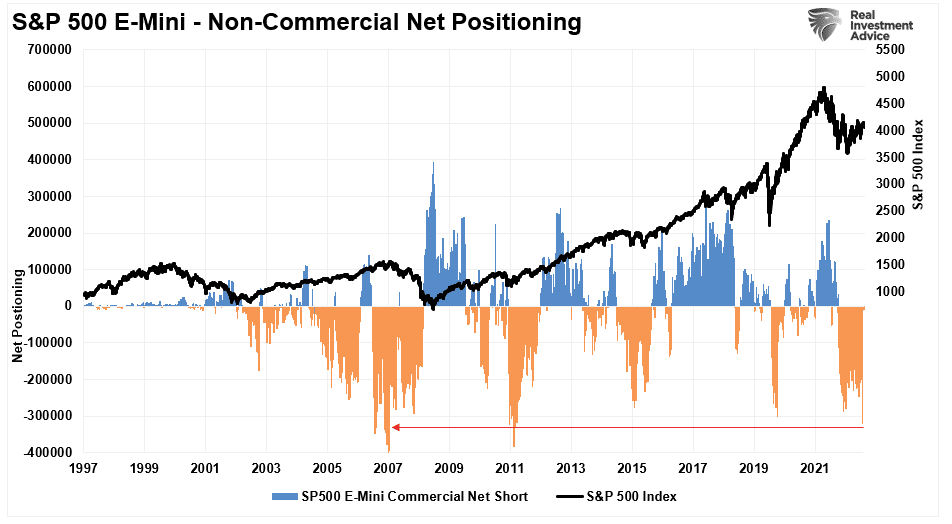
There are a couple of reasons why NCTs are shorting the market so extremely. The first is that they are betting on a further decline in the market. Such is possible given they were late shorting the market in 2022, and the recent rally from the October lows provides a better entry point. The second reason is they are hedging long positions in portfolios against a decline.
Given the still negative sentiment in the overall market, hedging portfolios is a logical choice. The difference between outcomes is dependent on whether the market is in a bullish or bearish cycle.
During the 2008 “Financial Crisis,” a true bear market, the COT net short position remained as market prices declined. This occurred as traders took short positions to speculate on the additional downside as the bear market unfolded.
However, since 2009, large net short positioning has denoted market bottoms. Each of the periods where the COT net short positioning became more extreme, such provided the “fuel” for the ongoing advance as traders were forced to cover their short-positioning as markets rose.
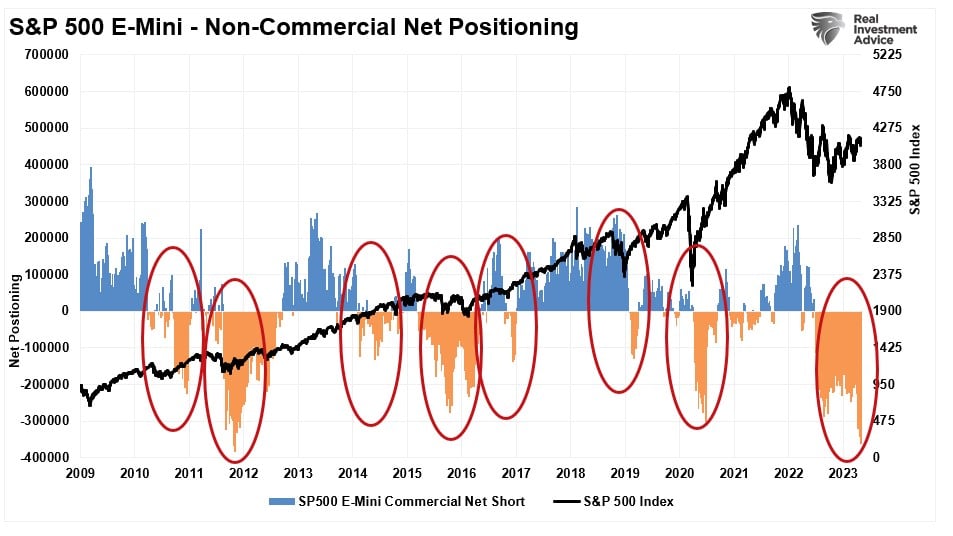
We must answer whether we are in a bullish or bearish trend. As I noted in “Rolling Recessions,” despite the correction in 2022, we remain clearly defined to a rising bull market trend.
“Since 2015, the market has traded in a well-defined bullish trend. Any breakout above or below that channel was quickly resolved. Notably, the market remains well above its 2019 peak. This is why the Fed continues to tighten policy as the “wealth effect” remains well entrenched, supporting inflationary concerns.
In late 2020, the market surged above the bullish trend channel as massive fiscal and monetary interventions fueled enormous speculation.”

The debate, however, is whether the correction from the previous market peak has been completed after successfully retesting and holding the bottom of the long-term trend channel. A look at a weekly chart, and the subsequent confirming buy signals, suggests such may be the case. When the market trades above the 40-week moving average, such tends to remain the case for an extended period. Notably, when the market is more than 10% above its 40-week moving average, that denoted market excesses that eventually reverse.
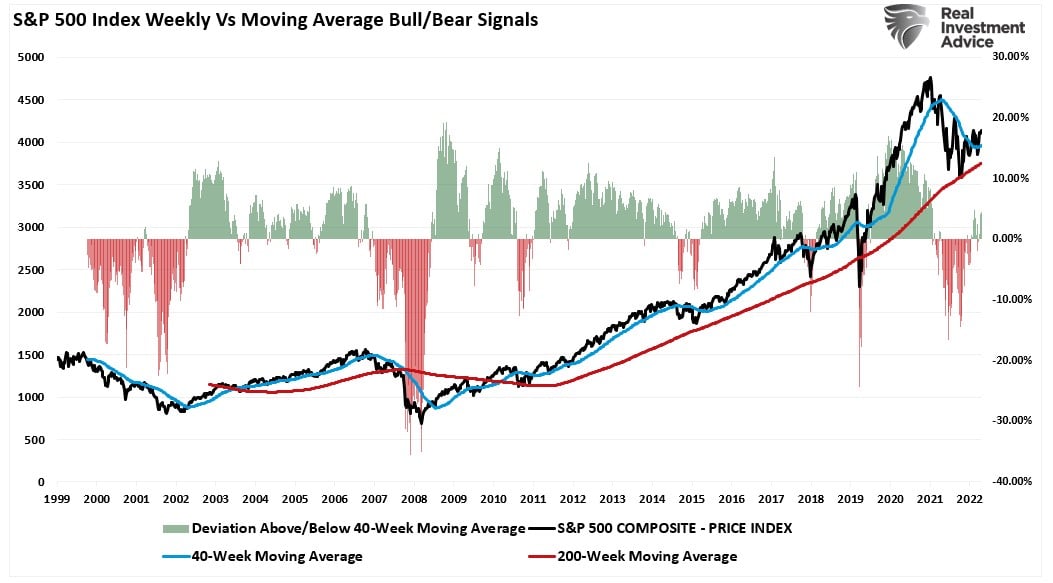
With the market now trading above the 40-week moving average, despite the bearish headlines and concerns of a recession, such generally suggests a more extended period of higher prices. If such is the case, that massive net short position could fuel an increased advance in the market in the months ahead.
All “Experts” Are Short Treasury Bonds
Interestingly, the COT data also shows that NCTs are heavily net short the 10-year Treasury Bond. This heavy negative positioning against the 10-year Treasury is one of the reasons we suggest that the “Bull Market In Bonds Is Set To Return.”
“People don’t buy houses or cars. They buy payments. Payments are a function of interest rates, and when interest rates rise, loan activity falls as payments rise above affordability. In an economy where 70% of Americans have little savings, higher payments significantly impact family budgets. Such is a critical point. Higher interest rates create ‘demand destruction.‘
While buying bonds today may still have some “pain” in them, we are likely closer to a significant buying opportunity than not. More importantly, if we are correct, the coming bull market in bonds will likely outperform stocks and inflation-related trades over the next 12-months. Such an outcome would not be the first time that happened. Of course, buying bonds when no one else wants them is a tough thing to do.”
The net short positioning on bonds is now at the highest since late 2018 amid the market meltdown over the Fed hiking interest rates. While yields today are marginally higher, the drop in yields will likely be significant when that short position reverses.
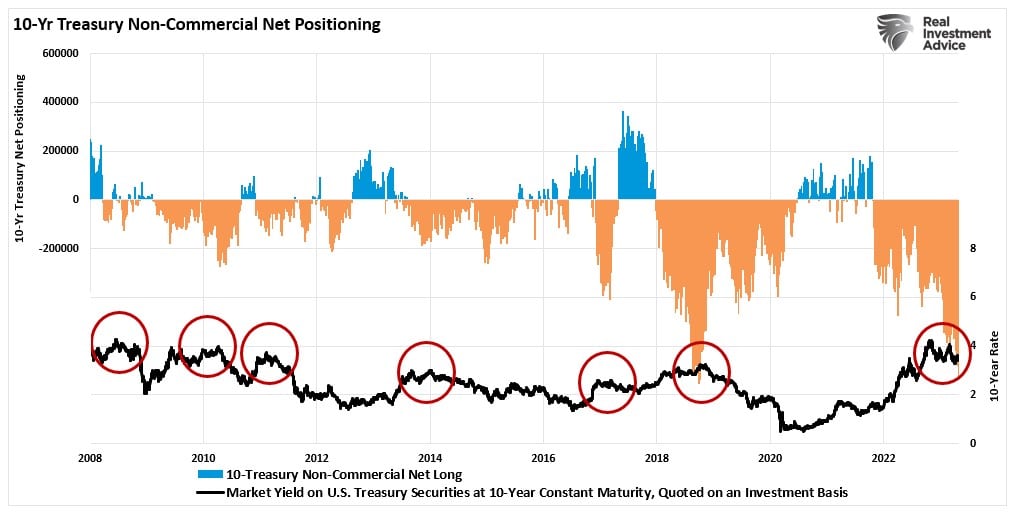
The chart below strips out all positioning except when the net short positioning exceeds 100,000 contracts. Not surprisingly, since 2000, each such condition was at, or near, a peak in interest rates. Notably, there was only one other period in our data where the net short positioning was so extreme. That period was in early 2018 as the Fed was hiking rates. Within 12 months, the Fed cut rates back to zero and was starting a massive repurchase operation to support the banks and hedgefund liquidity issues.
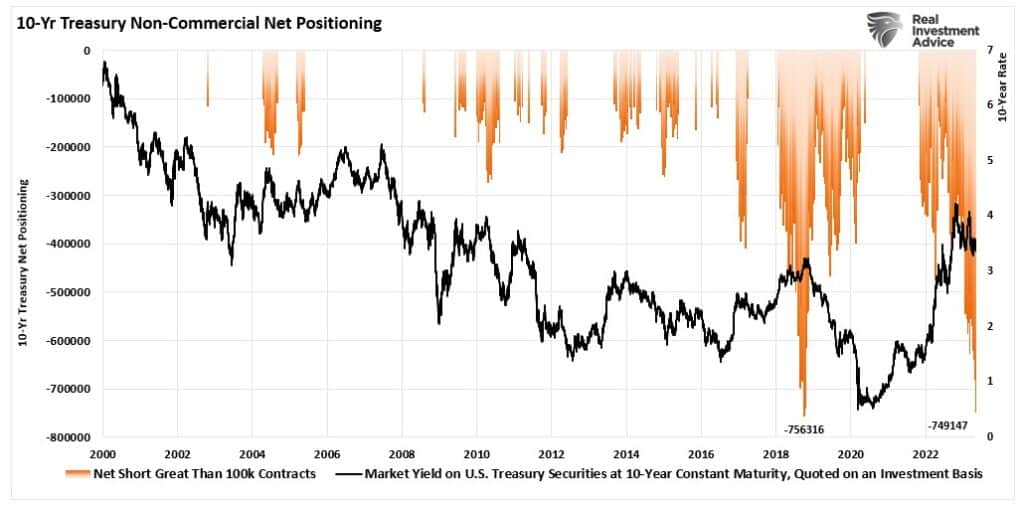
Of course, the obvious question is whether bears can simultaneously be wrong on stocks and bonds.
The Bears May Get Frustrated
Is it possible that the bears on both major markets (stocks and bonds) could become frustrated? History suggests such could be the case as stocks and bonds rally as the massive net short positions in the COT data are unwound.
The chart below is the monthly “real,” inflation-adjusted return of the S&P 500 index compared to interest rates. The data is from Dr. Robert Shiller, and I noted corresponding peaks and troughs in prices and rates.
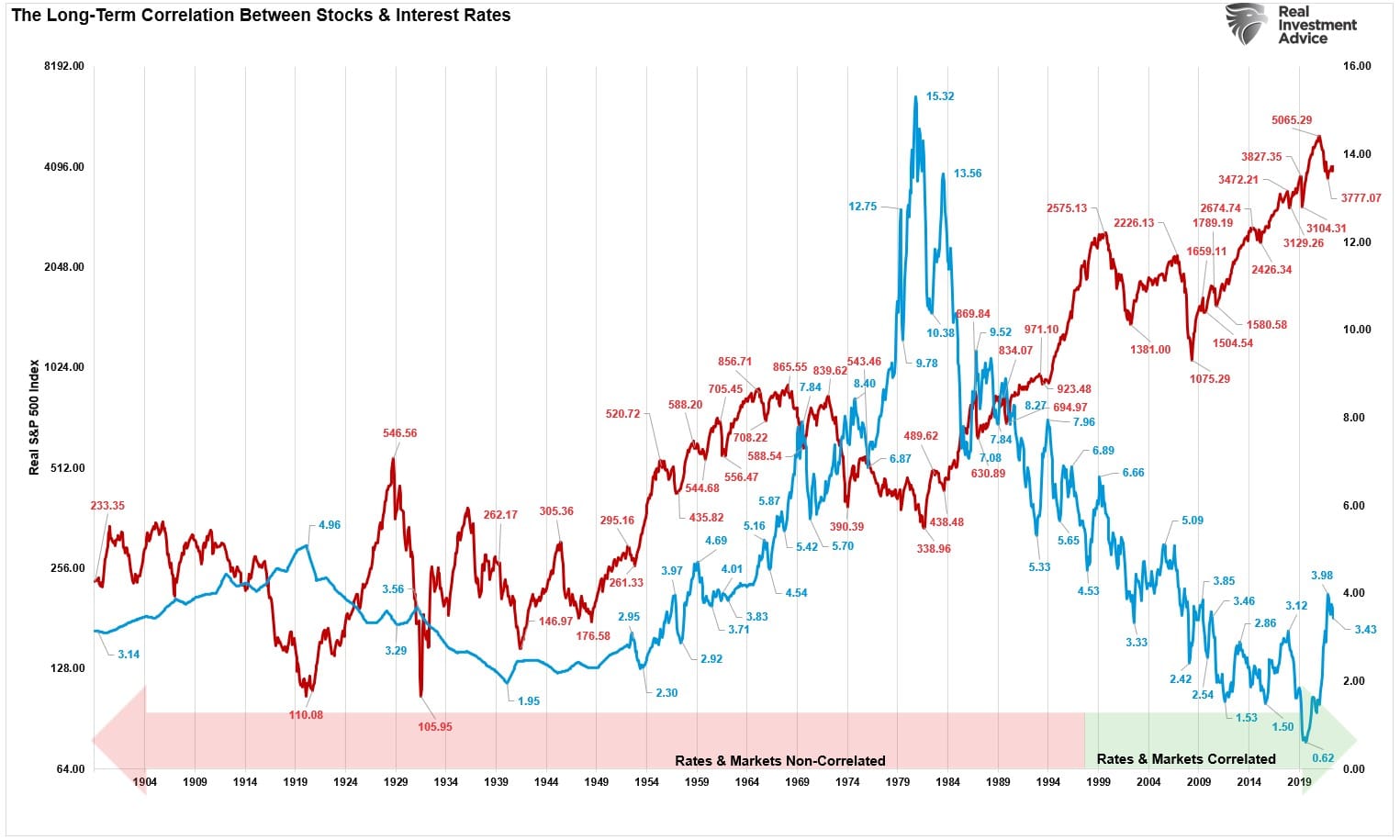
The data is a bit cluttered when looking at it in this manner. However, even an untrained eye can pick up that spikes in interest rates led to unfavorable outcomes for stocks. To understand the relationship between stock and bond returns over time, I took the data from the chart and created the table below of 47 periods over the last 123 years.
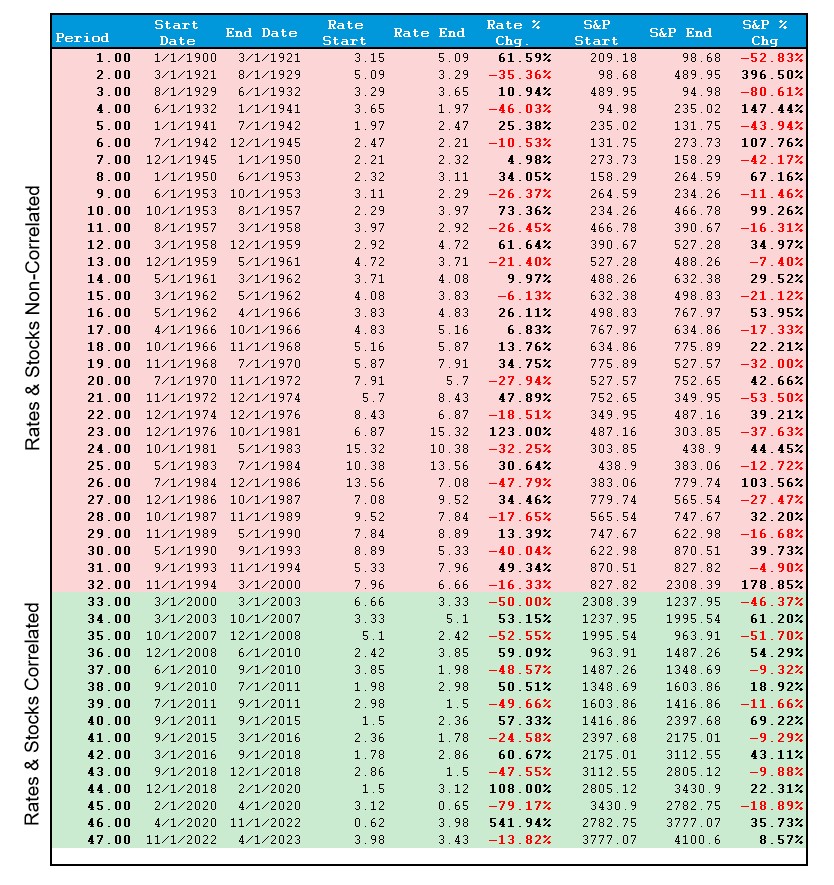
What jumps is the high degree of non-correlation between 1900 and 2000. As one would expect, if rates fell, stock prices rose in most instances. However, the opposite also was true. The chart below shows each of the 47 periods graphically.

The historical non-correlation changed in 2000, and rate movements and stock prices became correlated. The Federal Reserve is the only change that explains this immediate switch from non-correlation to correlation.
Importantly, since the turn of the century, both stock and bond markets have been correlated. Given the extreme net short positioning in the COT data, the bears on both sides may be wrong. Such is why it is crucial to ignore the media headlines, and one-sided commentaries, in favor of the data.
As I concluded in our recent missive on “Conviction,” it isn’t “being wrong” that is the biggest risk to your money. It’s “staying wrong,” that is.
Is this time different? Possibly.
But this is why we continue to focus on the data rather than the hyperbole.
